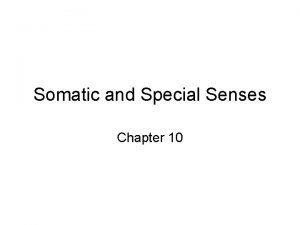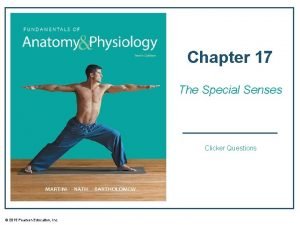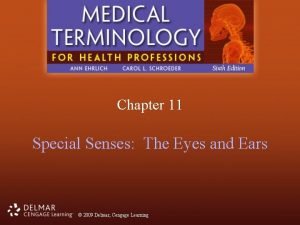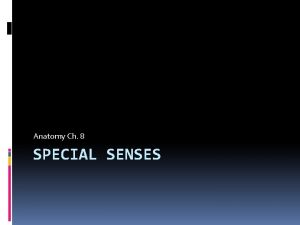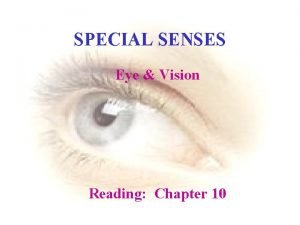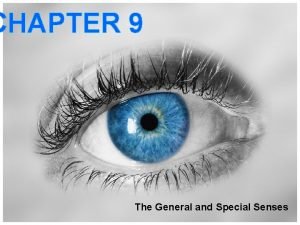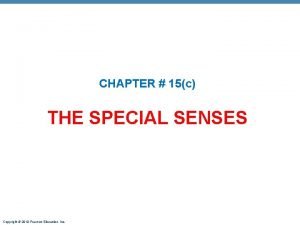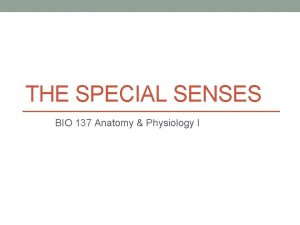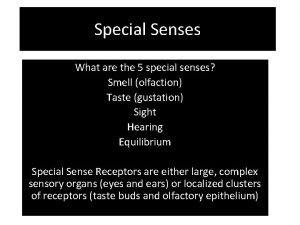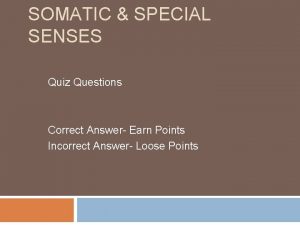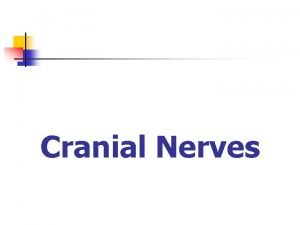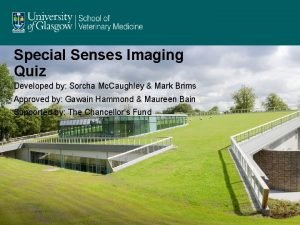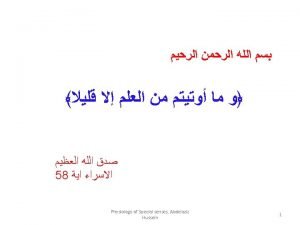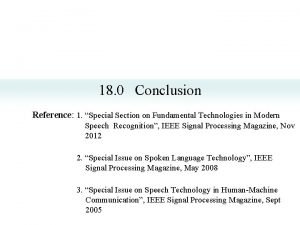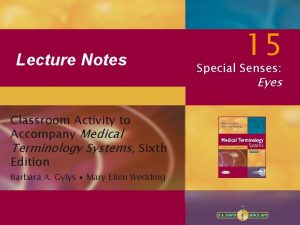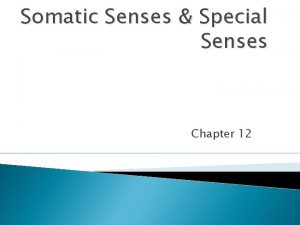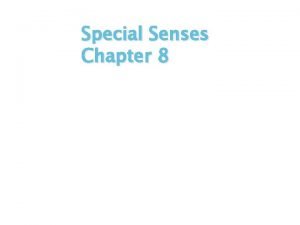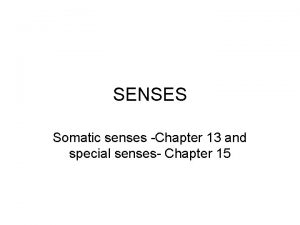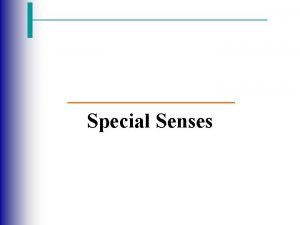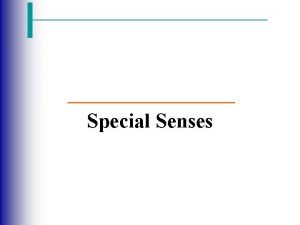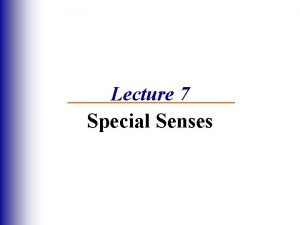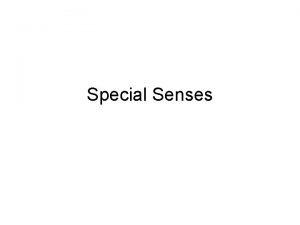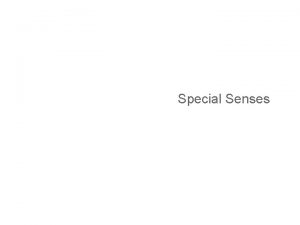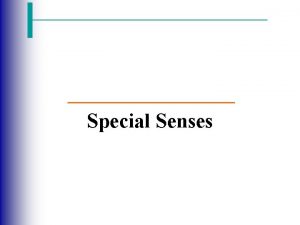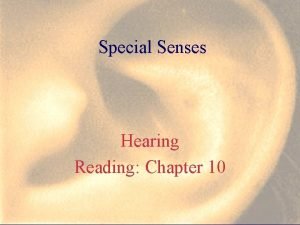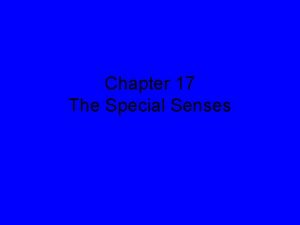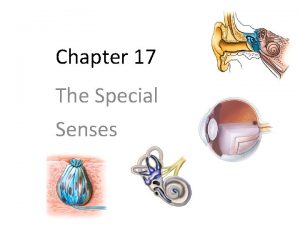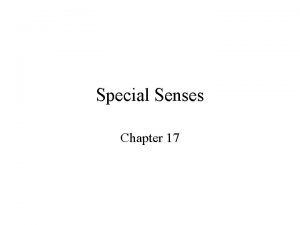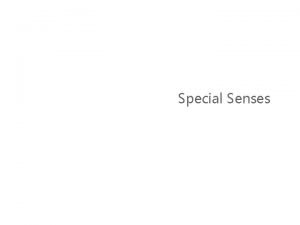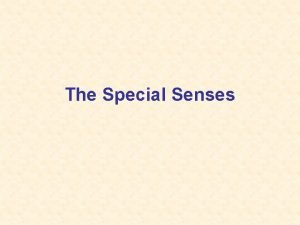Special Senses Hearing Reading Chapter 10 C HEARING


















- Slides: 18

Special Senses Hearing Reading: Chapter 10

C. HEARING 1) Outer ear a) auricle = pinna, why is this structure important? b) external auditory meatus = ear canal lined w/ wax glands & hairs c) tympanic membrane = “ear drum” vibrates when sound waves hit it

2) Middle ear a) auditory ossicles -malleus, incus, stapes -stapes attached to oval window b) tympanic cavity -cavity where ossicles are found -Eustachian tube = pressure release, “pop” b/c tympanic membrane moves -bacteria & viruses move up tube to infect middle ear (Otitis media)

3) Inner ear a) Cochlea = a fluid filled tube (coiled “snail shell”) b) Semi-circular canals = 3 structures, monitor angular acceleration c) Utricle & Saccule = within vestibule, monitor linear acceleration NOTE: bony labyrinth & membranous labyrinth

3) Inner ear a) Cochlea = a fluid filled tube (snail shell) 2 windows: 3 tubes: -oval window & round window -scala vestibuli, filled with perilymph -scala tympani, filled with perilymph -cochlear duct, filled with endolymph meet at helicotrema Cochlea “unwound”

3) Inner ear (cochlea con’t) The 3 fluid filled tubes are separated by 2 membranes: a) basilar membrane -separates cochlear duct from scala tympani b) vestibular membrane -separates scala vestibuli from cochlear duct

c) Organ of Corti: -a. k. a “spiral organ of corti” -contains hearing transducers (hair cells) -sits on basilar membrane -hair cells stick into tectorial membrane -movement of the hair cells creates AP’s *

Inner ear continued • d) Tectorial membrane is just above the organ of corti • e) Scala Vestibuli and scala tympani are filled with perilymph • f) Cochlear duct is filled with endolymph


4) Physiology of hearing a) b) c) d) e) f) Sound waves strike the tympanic membrane Ossicles move, stapes moves pushes into oval window Fluid wave moves the membranes of inner ear Hair cells strike tectorial membrane When hair cells bend, it creates an AP Auditory cortex of ______ lobe interprets sensory impulses NOTE: Round window bulges to relieve fluid pressure in the bony labyrinth

Basilar membrane: -high frequency waves vibrate near oval window -lower pitch sound waves vibrate near helicotrema

Loud vs. Soft Noises Volume increases as more hair cells are stimulated.

5) Deafness - 2 major types a) conduction deafness: Cause: -lack of conduction to cochlea -ear wax build up -damaged tympanic membrane -damaged ossicles Solution: -stimulate cochlea directly

5) Deafness - 2 major types b) nerve deafness: Cause: -damage to the organ of Corti -damage to vestibulocochlear nerve -tumors or bleeding in CNS -some drugs

D. EQUILIBRIUM - inner ear, vision and proprioception 1) utricle & saccule -2 chambers within vestibule -contain hair cells embedded in maculae -otoliths = rocks in maculae -linear or static movement detected -Utricle detects horizontal acceleration -Saccule detects vertical acceleration


2) Semicircular Canals - 3 fluid-filled canals - At right angles to one another - Hair cells embedded in a cupulae (sail) - Detect angular acceleration - Stimulation of the canals causes nystagmus & sometimes vertigo Post. = cartwheel Lat. = long axis Sup. = somersault

 What is the difference between somatic and special senses
What is the difference between somatic and special senses General senses vs special senses
General senses vs special senses Chapter 10 somatic and special senses
Chapter 10 somatic and special senses Chapter 17 special senses answer key
Chapter 17 special senses answer key Learning exercises chapter 11 medical terminology
Learning exercises chapter 11 medical terminology Anatomy and physiology chapter 8 special senses
Anatomy and physiology chapter 8 special senses Cranucle
Cranucle Emmentropia
Emmentropia The general and special senses chapter 9
The general and special senses chapter 9 Chapter 15 special senses
Chapter 15 special senses Chapter 15 special senses
Chapter 15 special senses Bio 137
Bio 137 5 basic tastes
5 basic tastes The cones of the retina are coursera quiz answers
The cones of the retina are coursera quiz answers Special senses cranial nerves
Special senses cranial nerves Special senses quiz
Special senses quiz Special senses
Special senses Conclusion of special senses
Conclusion of special senses Building vocabulary activity: the special senses
Building vocabulary activity: the special senses


